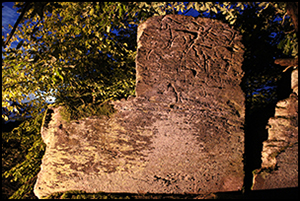Article contents
First Palaeolithic rock art in Germany: engravings on Hunsrück slate
Published online by Cambridge University Press: 17 February 2016
Abstract

The engravings discovered on a slate rock face near the village of Gondershausen in the Hunsrück Mountains in 2010 represent the northernmost example of open-air Palaeolithic rock art in Europe, and the first in Germany. Analysis of the style and technique of the Hunsrück images reveals significant parallels with Palaeolithic cave art from other parts of Europe, most notably France. The oldest of the images at Gondershausen—three horses in particular—may be attributed to the Aurignacian or Gravettian. The survival of these Palaeolithic engravings through the Last Glacial Maximum is testimony to the unusual circumstances of their preservation.
- Type
- Research
- Information
- Copyright
- Copyright © Antiquity Publications Ltd, 2016
References
- 3
- Cited by


